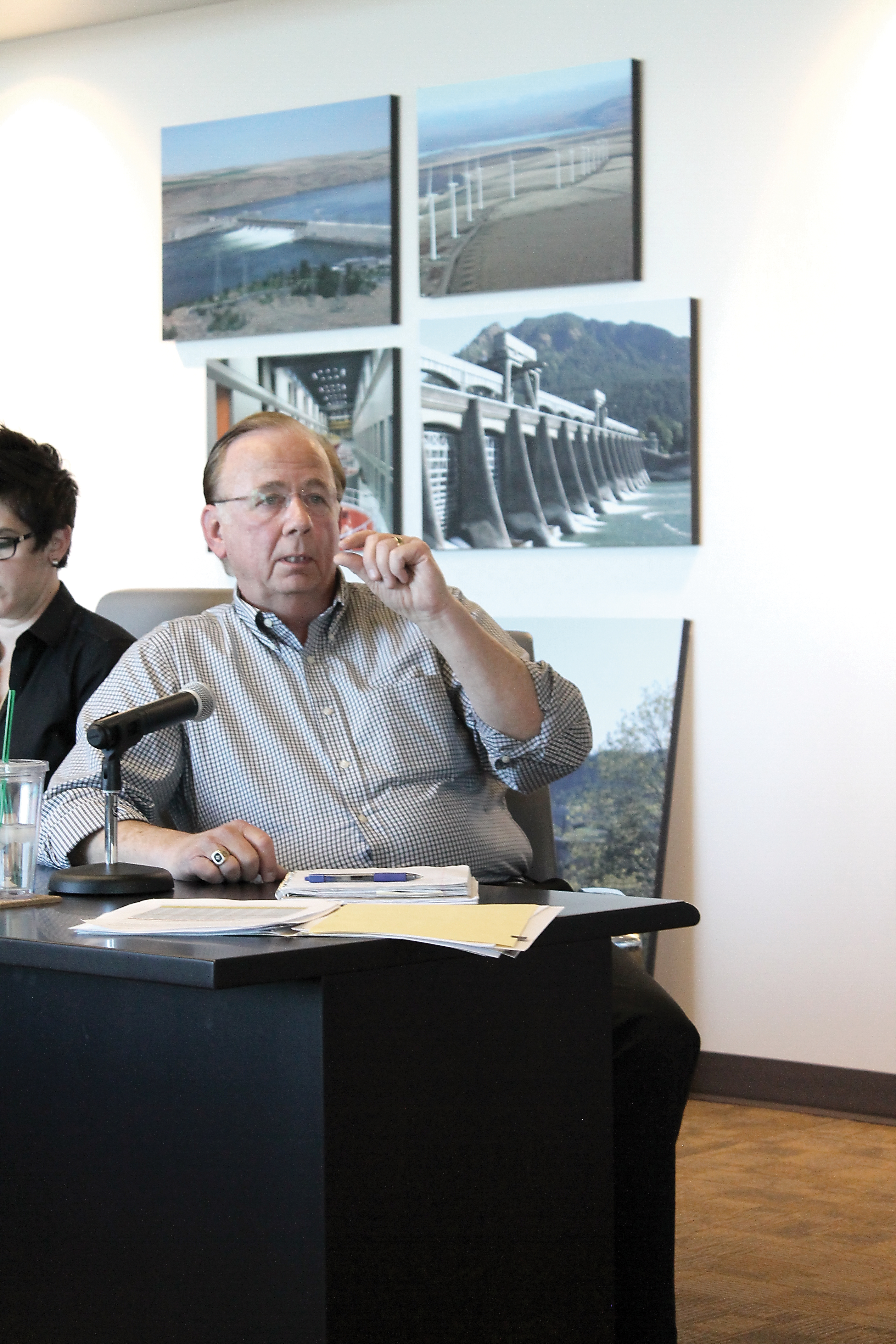SEQUIM — Clallam County Public Utility District commissioners have confirmed their stance against a proposed carbon tax.
The three-member board voted unanimously Monday to adopt a resolution opposing Initiative 732, which will come before the voters in the Nov. 8 general election.
“I think we can do a lot better than this and get a lot more accomplished,” Commissioner Ted Simpson said.
The carbon tax, sponsored by a nonpartisan grass roots group Carbon Washington, aims to encourage sustainable economic growth and a reduction in carbon emissions by taxing, per ton, carbon dioxide (CO2) pollution from fossil fuels.
The commissioners’ decision on the initiative came immediately after public comments were heard. Most comments were from proponents of the tax.
Mike Massa of the Carbon Washington executive committee was among about 25 people attending Monday’s meeting.
“What I would encourage you to do is consider the impact of the entire policy on your customers and not just the impact of electricity rates,” Massa told the commissioners during public comment.
“There are costs to doing nothing, so when evaluating a policy, you need to look at both sides of the equation.”
Economic estimates
Although I-732 enacts a new tax on energy beginning in 2017 at $15 per ton of CO2 emissions, it’s expected to be revenue-neutral.
To balance the tax, I-732 is set to reduce the state sales tax by 1 percent, fund the Working Families Rebate and eliminate the business and occupation tax for manufacturers.
“What we’ve found is that for the average family, they’ll pay a few hundred dollars more per year in energy costs due to the carbon tax, but they’ll save a few hundred dollars per year from the 1 percent reduction in state sales tax,” Massa said.
“Businesses also pay sales tax and also will get the same trade-off, especially small businesses with low energy costs.”
The tax cuts identified under I-732 are “intended to protect low- and middle-income persons from the impact of the energy tax,” he said.
Per the policy proposal, following 2017, the tax would jump to $25 per ton CO2 in 2018 and annually increase by 3.5 percent plus inflation up to $100 per ton.
It’s expected to take an estimated 40 years to reach the full tax amount, Massa said.
Relying on estimates provided by the Washington PUD Association, I-732 would increase Clallam PUD’s energy costs between $500,000 and $1.8 million within the first year.
By year two, cost estimates range between $900,000 and $3 million.
In 2025-26, the tax liability is projected to be between $1.2 million and $4.1 million.
“My focus is pretty narrow, and I’m looking at the impacts to our ratepayers,” Commissioner Will Purser said.
PUD officials anticipate the energy tax would equate to a 1 percent to 4 percent electricity rate increase within its first year.
Despite the projected rate increases, from a “raw economic” perspective, I-732 actually favors the utility’s ratepayers, said Mike Doherty, resident and past Clallam County commissioner.
Based on the taxable sales for Clallam County per the state Department of Revenue, he said, there’s more than $9 million in sales tax cuts brought about by I-732.
“If you look at what appears to be the PUD fuel mix that’s on the Department of Commerce website, it looks like at the $25-a-ton scenario, you would have an impact of about $320,000,” he said.
Comparing the benefits to the taxpayers against the impact on the PUD, Doherty said, “disproportionately, young working families, seniors and the rest of the citizens on fixed incomes are going to have a huge gain.”
Market purchases
The range in increased energy cost projections for Clallam PUD are based on Bonneville Power Administration’s (BPA) need to make open market purchases usually spurred by demands for more electricity, often during times of lower hydropower generation.
The electricity purchased to meet demands comes from a “pool of unspecified electricity resources” that could be anything from wind, solar or natural gas, Michael Howe, PUD spokesman, said during a May 2 meeting.
“The cost is projected to vary depending on how much hydropower is available and the need for market purchases,” he said.
“We are projecting the tax would be imposed on between 4 percent and 14 percent of the electricity we purchase from BPA.”
Clallam PUD supplies its electricity via mainly carbon-free resources, but I-732 assumes some level of carbon dioxide emissions, Howe said.
Massa disagreed with the estimated cost impacts by the Washington PUD Association. He said they overestimated by about 18 percent.
“They used a much higher figure for the carbon intensity of those purchases,” he said.
Differences in energy cost impact aside, Simpson said, “the other thing that makes I-732 really difficult” is the utility’s responsibility to collect the tax is based on an estimated amount of CO2 emissions.
“We don’t know what amount of carbon is being emitted for up to 18 to 24 months because it’s calculated by the Department of Commerce,” he said.
For Clallam PUD General Manager Doug Nass, the “big plus” associated with taxing CO2 emissions in Washington is the opportunity to set an example, “but we’re 99 percent clean already,” he said.
Massa said that should lead commissioners to support I-732 because it would pay little while encouraging the rest of the state to reduce emissions.
Nass believes Clallam County PUD can and should do better and continue to move toward renewables, but based on the cost estimates from the Washington PUD Association tied to I-732, “we see a major impact to our customers.”
________
Alana Linderoth is a reporter with the Olympic Peninsula News Group, which is composed of Sound Publishing newspapers Peninsula Daily News, Sequim Gazette and Forks Forum. Reach her at alinderoth@sequimgazette.com.
